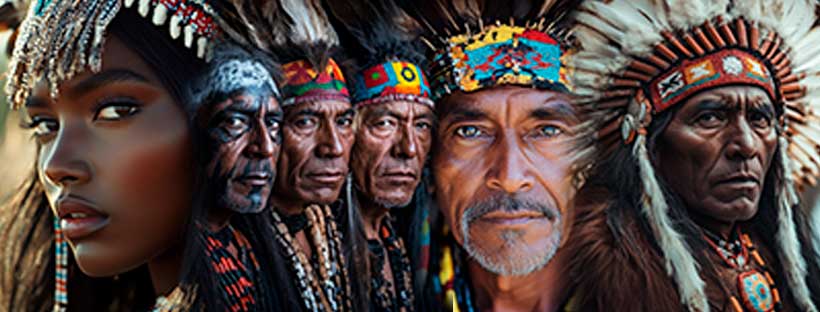
Unveiling the Buried Truth
Share
Black Americans as the True Indigenous People of America
Historical records, murals, and encyclopedias collectively illuminate a narrative that has long been suppressed: Black Americans are not merely descendants of enslaved Africans but are also the true Indigenous people of America. This revelation challenges centuries of fabricated histories and systemic erasure, laying bare a calculated effort to obscure the identity, heritage, and sovereignty of these original inhabitants.
The True Nations: Powhatan, Iroquois, Algonquin, and Beyond
Before terms like "American Indian" were introduced, the original people of North America were known by the names of their nations, tribes, and confederacies. Among them were the Powhatan, Iroquois, and Algonquin—powerful and influential groups that thrived across the continent. These nations were not isolated; they had connections to royal lineages in Europe and North Africa, especially among the Berbers, known historically as Moors. These connections underscore a shared legacy of governance, cultural sophistication, and global influence.
The Powhatan Confederacy, for instance, was an empire that dominated the mid-Atlantic region, wielding considerable power through diplomacy and trade. Similarly, the Iroquois Confederacy—revered for its sophisticated governance structure—served as an inspiration for democratic principles later adopted in the United States. These were not small, nomadic tribes but expansive nations that negotiated treaties, built thriving societies, and contributed to the development of civilization as we know it.
The Agenda of Erasure: Walter Plecker’s Role in Reclassification
Walter Ashby Plecker, the first director of Virginia's Bureau of Vital Statistics, was a pivotal figure in the erasure of these lineages. From 1912 to 1946, Plecker implemented policies that reclassified millions of Indigenous people as "Black," effectively erasing their tribal identities and severing their legal ties to treaties and land rights. This reclassification was not accidental; it was part of a broader agenda to dismantle the sovereignty and heritage of these communities.
Plecker's actions were rooted in white supremacist ideology, which sought to rewrite history and consolidate power by delegitimizing Indigenous claims. By categorizing Native Americans with African ancestry as "Negro," he ensured that they would be subject to Jim Crow laws, denied access to their ancestral lands, and excluded from the legal protections afforded to recognized tribes.
Cultural Erasure as a Tool of Oppression
The reclassification extended beyond bureaucratic paperwork—it was a cultural assault. The rich traditions, oral histories, and royal lineages of these nations were dismissed or misrepresented, replaced by stereotypes and caricatures that stripped them of their humanity and dignity.
Murals in Mexico and early colonial accounts provide visual and written evidence of the dark-skinned Indigenous people who lived and thrived across the Americas. These depictions challenge the stereotypical "Asian-looking" image of Native Americans that has been popularized. Instead, they highlight a diversity of features that align more closely with the ancestry of Black Americans.
Walter Plecker's efforts were not isolated but part of a larger colonial strategy that relied on renaming, reclassification, and the destruction of historical records. These tactics were designed to break the continuity of cultural memory, leaving future generations disconnected from their true identities.
The Consequences of Identity Theft
The implications of this reclassification were profound. By erasing their identities as Indigenous people, millions were denied their rightful place in history and their legal claims to land and resources. Treaties signed by their ancestors—many of which guaranteed land, autonomy, and other rights—became void in the eyes of the state. The lands they inhabited were declared abandoned and redistributed to settlers, cementing the economic disenfranchisement of Black Indigenous people.
This theft of identity also created a false dichotomy between "Black" and "Native," forcing individuals to choose one aspect of their heritage while denying the full scope of their ancestry. This division has perpetuated confusion and hindered the collective efforts of these communities to reclaim their rights.
Reclaiming the Narrative
Understanding this history is the first step toward justice. Black Americans must recognize their dual heritage as both descendants of African ancestors and the original Indigenous people of America. This recognition is not just a matter of pride but a call to action to reclaim the land, culture, and sovereignty that have been systematically denied.
Efforts to rewrite this narrative must include education, advocacy, and the legal pursuit of land patents and treaty rights. The murals, historical accounts, and genealogical records that tell the true story of Black Indigenous people must be preserved and amplified, ensuring that future generations understand the depth and breadth of their heritage.
In reclaiming this narrative, Black Americans can restore their place as sovereign heirs to a land and legacy that was never truly lost—only deliberately hidden. The time has come to uncover the buried truths, dismantle the structures of oppression, and honor the indomitable spirit of those who came before.
